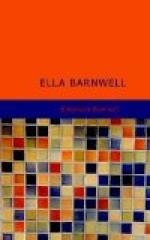“From morn till night, from night till morn,”
sung gentle melodies for all who chose to listen.
The building itself though rough, both externally and internally, was what at that period was termed a double cabin; and in this respect was entitled to a superiority over most of its neighbors. As this may serve for a representative of the houses or cabins of the early settlers of Kentucky, we shall proceed to describe its structure and general appearance somewhat more minutely than might otherwise be deemed necessary.
The sides of the cottage in question, were composed of logs, rough from the woods where they had been felled, with the bark still clinging to them, and without having undergone other transformation than being cut to a certain length, and notched at either end, so as to sink into each other, when crossed at right angles, until their bodies met, thereby forming a structure of compactness, strength and solidity. Some ten or twelve feet from the ground, the two upper end logs of the cabin projected a foot or eighteen inches beyond the lower, and supported what were called butting poles—poles which crossed these projections at right angles, and, extending along the front and back of the building, formed the eaves of the roof. This latter was constructed by gradually shortening the logs at either end, until those which crossed them, as we said before, at right angles, came together at an angle of forty-five degrees, and the last one formed the ridge-pole or comb of the whole. On these logs, lapping one over the other, and the lower tier resting against the butting poles, were laid slabs of clapboard—a species of plank split from some straight-grained tree—about four feet long, and from three to four wide. These were secured in their places by logs in turn resting on them, at certain intervals, and answering the purpose of nails; necessity requiring these latter articles of convenience to be dispensed with in the early settlements of the West. As the cabin was double, two doors gave entrance from without, one into either apartment. These entrances were formed by cutting away the logs for the space of three feet by six, and were closed by rude doors, made of rough slabs, pinned strongly to heavy cross bars, and hung on hinges of the same material. These, like the rest of the building, were rendered, by their thickness, bullet proof—so that when closed and bolted, the house was capable of withstanding an ordinary attack of the Indians. With the exception of one window, opening into the apartment generally occupied by the family, and flanked by a heavy shutter, the doors and chimney were the only means through which light and air were admitted. These were all firmly secured at night—the unsettled and exposed state of the country, and the dangerous proximity of the pioneers to the ruthless savage, particularly those without the forts, rendering necessary, on their part, the most vigilant caution.




